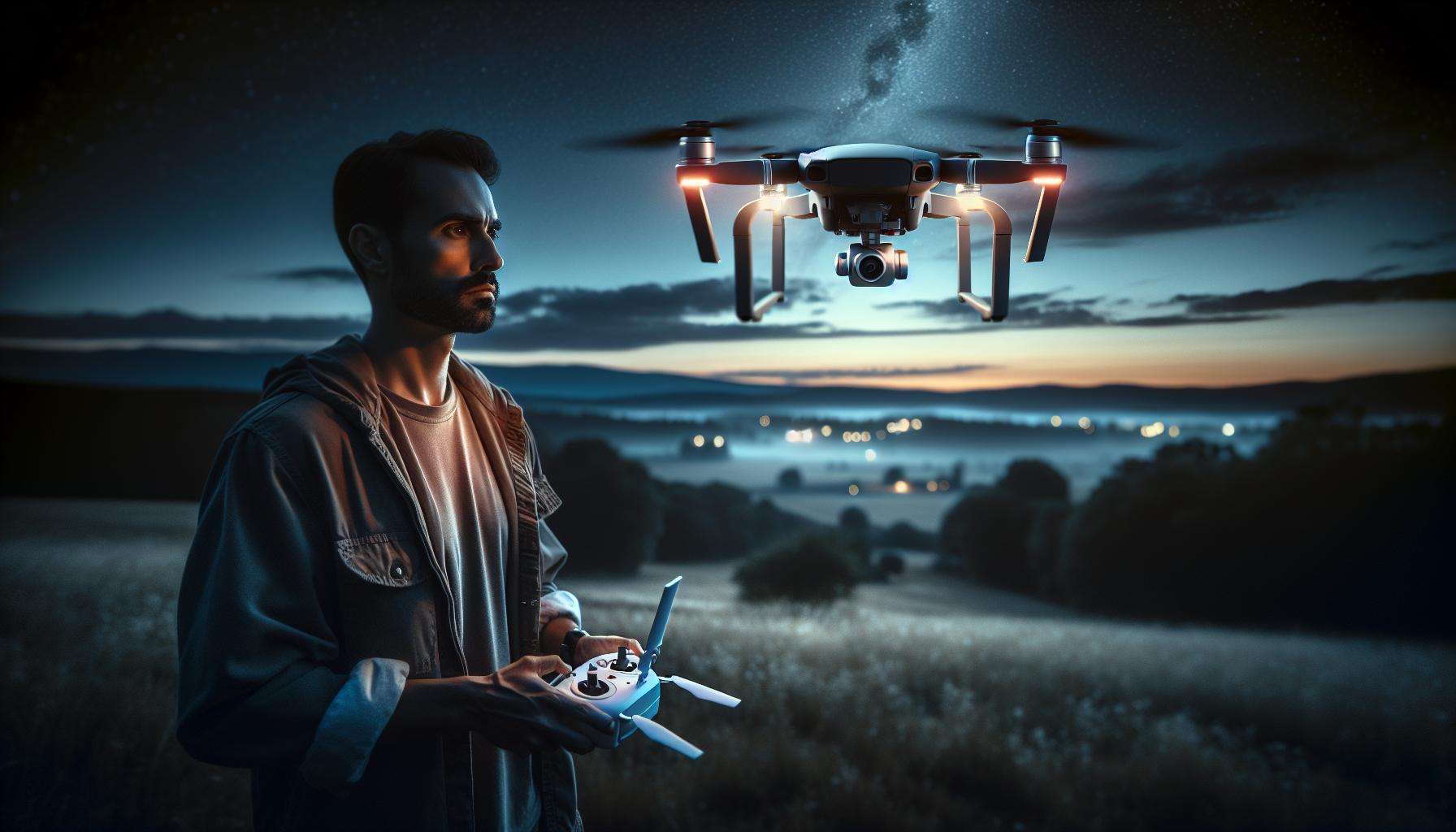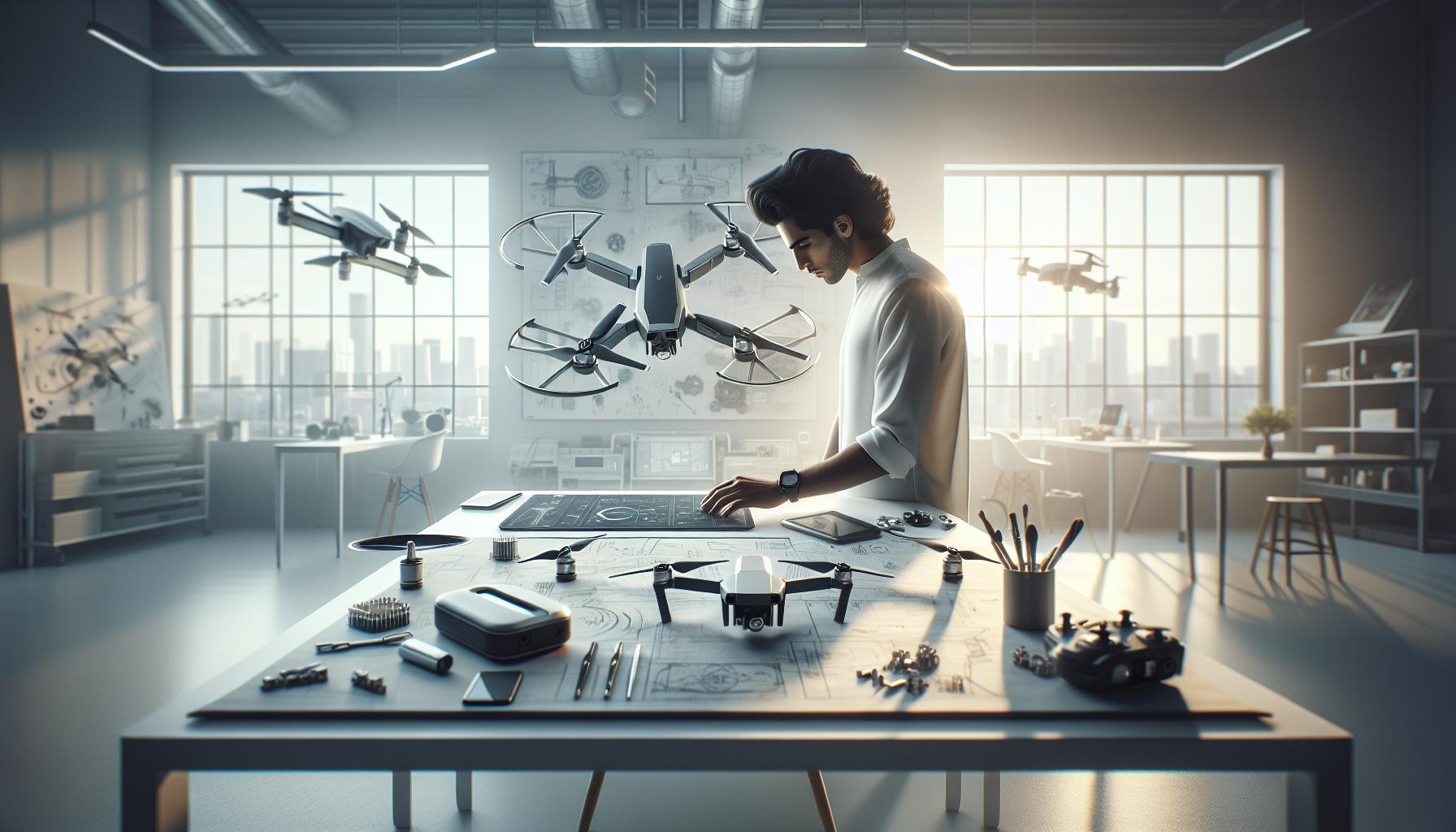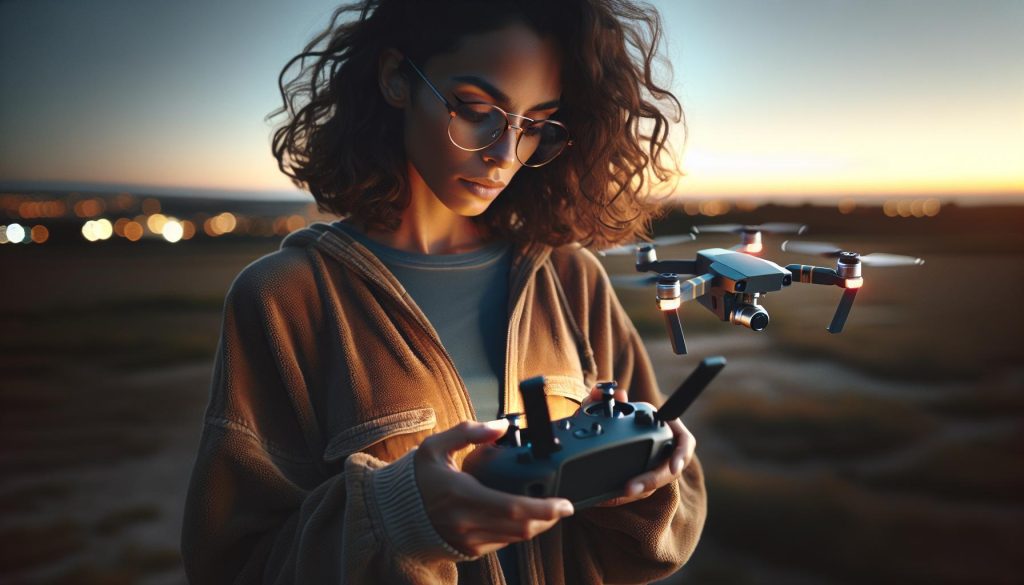As drone technology evolves, the ability to fly at night has become a tantalizing prospect for many aerial enthusiasts. The DJI Mini 4 Pro, known for its compact design and impressive features, raises the question: can it truly operate after dark? Understanding night flight rules is crucial for both safety and compliance, making this topic highly relevant for hobbyists and professional pilots alike. With stunning nighttime aerial imagery just a flight away, pilots may be eager to explore how to navigate the complexities of low-light operations. Join us as we delve into the essential regulations and practical tips that will empower you to safely elevate your drone adventures even when the sun goes down. Discover the boundaries of night flying and unlock new creative possibilities with your DJI Mini 4 Pro!
Can the DJI Mini 4 Pro Fly Safely at Night?
The DJI Mini 4 Pro is a remarkable piece of technology that opens up new avenues for aerial photography and videography, especially at night. While it is equipped with enhanced functionalities, flying at night requires a keen understanding of both the drone’s capabilities and the related safety protocols. To ensure a safe night flight, pilots must adhere to strict regulations and employ adequate lighting and visibility measures.
Prior to taking off after sunset, familiarize yourself with local regulations surrounding night flights. In many regions, flying a drone at night necessitates appropriate lights to ensure visibility. The FAA, for example, mandates that drones must be equipped with anti-collision lighting that can be visible for at least three statute miles. In addition to following these regulations, consider using the Mini 4 Pro’s advanced obstacle detection system, which helps maintain a safe space between the drone and its environment even in low-light conditions.
To optimize your DJI Mini 4 Pro for night flights, focus on securing the proper accessories. Attach bright LED lights to the drone for visibility against the night sky, helping others see your aircraft while also giving you better spatial awareness. Utilize the drone’s camera settings to adjust ISO levels, allowing for clearer images in darker conditions. Furthermore, ensuring that your drone’s firmware is up-to-date can enhance performance and functionality during low-light scenarios.
Ultimately, while the DJI Mini 4 Pro can fly safely at night with the right precautions and equipment, maintaining operational limits and legal compliance is essential. Plan your night flights carefully, ensuring that you maintain visual line-of-sight and awareness of your surroundings to mitigate risks associated with reduced visibility.
Understanding Night Flight Regulations for Drones
Flying drones at night presents a thrilling opportunity for pilots to capture stunning aerial imagery, yet it also comes with a distinct set of regulatory challenges that must be meticulously navigated. Understanding these regulations not only ensures safety but also enhances the quality of your night-flight experience. According to the Federal Aviation Administration (FAA) guidelines, specific requirements must be met to legally operate drones like the DJI Mini 4 Pro after dark.
First and foremost, it is essential to equip your drone with anti-collision lighting. The FAA mandates that such lights must be visible for a minimum of three statute miles, which is crucial for both safety and compliance. These lights not only aid in making your drone visible to others but also provide valuable cues for the operator regarding the drone’s position in the night sky. When planning your flight, be aware of any local laws that may impose additional restrictions or conditions for night flying, which can vary widely between jurisdictions.
Furthermore, maintaining visual line-of-sight (VLOS) is a cornerstone of night-flying regulations. This means that you must keep your drone in view without the use of any devices like binoculars or screens. Given the low visibility conditions, enhanced situational awareness becomes paramount. Utilizing the Mini 4 Pro’s built-in obstacle detection features can help mitigate risks, but it should never replace the pilot’s responsibility to maintain direct visual oversight of the drone.
It’s also advisable to register your drone (if required) and familiarize yourself with airspace classifications in your area. Certain zones, especially near airports or crowded urban environments, might impose stricter regulations or might entirely prohibit night flying. Conducting thorough pre-flight planning, including checking for Temporary Flight Restrictions (TFRs) and weather conditions, can enhance safety and compliance during your night operations.
By understanding and adhering to these night flight regulations, pilots can enjoy the vast potential of nocturnal drone operations while promoting safety for themselves and others in the vicinity.
Essential Equipment for Night Flying with DJI Mini 4 Pro
Flying at night can transform the way you experience aerial photography, but to ensure a safe and compliant flight, having the right equipment is essential. The DJI Mini 4 Pro is capable of amazing nocturnal flights, provided you are equipped with the tools that enhance visibility and safety.
One of the most critical pieces of equipment for nighttime flying is anti-collision lighting. These LED lights are not just a recommendation; they are a regulatory requirement by entities like the FAA. Your lights should be visible for at least three statute miles. This visibility not only keeps your drone compliant with legal standards but also helps other pilots and observers see your drone in the night sky. For the Mini 4 Pro, installing bright, lightweight LED lights on the drone’s body can dramatically improve visibility during flights.
In addition to lighting, utilizing a night vision goggle or display system is a game-changer. While the Mini 4 Pro’s camera can handle low light conditions to some extent, having a night vision system can provide you with a clearer view of your surroundings, especially in darker environments where obstacles might not be as apparent. This device allows for greater situational awareness and can be particularly useful during complicated maneuvers or in areas where light is minimal.
Moreover, consider carrying a backup battery specifically designed for night flying. Cold temperatures at night can affect battery performance, leading to unexpected drain, which could endanger your flight. Ensuring you have a fully charged spare battery on hand can give you the peace of mind needed to explore the night sky without the imminent fear of an abrupt landing due to low battery warnings.
As you gear up for your night flights with the DJI Mini 4 Pro, making these equipment considerations will enhance both the safety and enjoyment of your aerial adventures after dusk.
How to Optimize Your DJI Mini 4 Pro for Night Flights
To ensure a successful night flight with your DJI Mini 4 Pro, optimization extends beyond simply equipping the drone with the right lights and accessories; it involves a comprehensive approach that enhances performance and safety. Start by updating your drone’s firmware to the latest version. Firmware updates often include improvements that can enhance flight stability, especially in challenging low-light conditions. You can perform this through the DJI Fly app, where the process is straightforward. Once updated, calibrate the IMU (Inertial Measurement Unit) and compass pre-flight to ensure accurate positioning during your night operations.
Another crucial aspect of optimization is adjusting your camera settings for low-light performance. The Mini 4 Pro’s camera allows for manual adjustments, enabling you to optimize ISO, shutter speed, and white balance for nocturnal shots. Lowering the shutter speed and increasing the ISO will enhance light sensitivity, allowing you to capture clearer images and video even in dimly lit environments. Utilize the drone’s intelligent modes, like Night Mode, which automates some of these settings for optimal results.
Equipping your drone with additional accessories can further optimize your experience. Consider using a propeller guard to protect the blades from potential collisions with obstacles that may not be as visible at night. Additionally, implementing a dual-control setup with a spotter on the ground can enhance safety. This individual can assist with navigation and visually monitor the drone’s position when visibility is limited.
Finally, familiarize yourself with the area where you plan to fly. Pre-flight scouting during the day allows you to identify potential obstacles, define safe flight paths, and find suitable launch and landing locations. By taking these proactive steps, you can significantly enhance both the safety and effectiveness of your night flights, making the most of your DJI Mini 4 Pro’s capabilities after sunset.
Night Flight Tips: Maximizing Visibility and Control
Maximizing visibility and control during night flights with the DJI Mini 4 Pro is crucial for safe and effective operation. Droning at night offers unique challenges, including limited visibility and potential obstacles that may not be as noticeable in the dark. To enhance your flying experience, consider implementing a few key strategies.
One of the most effective ways to improve night visibility is by augmenting your drone with high-quality lights. Equipped with both front and rear lights, these can significantly extend your line of sight while also making your drone easily visible to others. Bright LED lights can illuminate your path and help detect obstacles, so consider installing additional lighting solutions that provide a broader coverage area.
In tandem with proper lighting, refining your flight techniques can greatly enhance control. Utilize the Mini 4 Pro’s GPS positioning for precise navigation and employ slower flying speeds to allow for better reaction time against unforeseen obstacles. Consider flying at a higher altitude where you can gain a clearer view of landmarks and other environmental features that help orient you in the dark. Utilizing the “Follow Me” or “Point of Interest” modes can also keep the camera focused while you concentrate on maintaining control.
Taking advantage of the DJI Mini 4 Pro’s intelligent flight modes further contributes to stability and safety. Mode settings such as “Tripod” mode reduce the drone’s sensitivity to control inputs, allowing for smooth movements that are particularly beneficial during night operations. Additionally, engaging obstacle avoidance features ensures the drone remains aware of its surroundings, giving you peace of mind as you navigate through dimly lit areas.
Night flights can be particularly rewarding when conducted with the right preparedness. Prior to takeoff, familiarize yourself with the area from which you’ll be flying. This helps in understanding the landscape and identifying potential hazards. Always have a reliable plan to return, particularly if you lose sight of the drone or if the battery is running low. With the right techniques and equipment, flying the DJI Mini 4 Pro at night can become a thrilling and safe adventure.
Common Challenges of Night Flying and Solutions
Flying a drone at night can be exhilarating, but it also presents distinct challenges that require careful planning and preparation. The DJI Mini 4 Pro, while capable of night operations, demands a thorough understanding of these potential obstacles to ensure a safe flying experience. Understanding the common challenges of night flying is crucial for both novice and experienced pilots alike.
One major issue when flying at night is reduced visibility. With less ambient light, pilots often struggle to see their drones and the surrounding environment. To counteract this, equipping your Mini 4 Pro with high-intensity LED lights is essential. This not only illuminates your path but also increases the drone’s visibility to others. Consider using lights that can be adjusted for intensity to accommodate different environments.
Navigational difficulties are another concern. The lack of visual references can make it challenging to maintain orientation. Utilizing GPS and the Mini 4 Pro’s intelligent flight modes, such as “Return to Home,” can help in maintaining control and ensuring a safe return in the event of disorientation. It’s advisable to familiarize yourself with the area you plan to fly in during daylight hours to establish a mental map for nighttime operations.
Another challenge is battery efficiency. Cold temperatures at night can affect battery performance, leading to shorter flight times. To address this, ensure your drone’s batteries are fully charged and consider preheating them before flight if temperatures drop significantly. Monitoring battery levels frequently during your night flight is vital; a good practice is to set a threshold for battery return to avoid unexpected landings.
Lastly, while the Mini 4 Pro has advanced safety features like obstacle detection, nighttime flying may still present unseen hazards. Employing slower, more cautious flying speeds and keeping a steady altitude can help mitigate the risk of collisions. Pairing these techniques with regular practice in varying light conditions will enhance your overall confidence and control in nighttime situations. With adequate preparation and awareness of these challenges, flying the DJI Mini 4 Pro at night can become a rewarding experience.
Battery Life Considerations for Night Operations
Flying a drone at night can be an enchanting experience, but it comes with its own set of challenges, particularly regarding battery life. The performance of the DJI Mini 4 Pro’s battery can be significantly impacted by the cooler nighttime temperatures, leading to reduced efficiency and shorter flight times. Therefore, understanding how to manage and maximize battery life during night flights is critical for a successful experience.
To begin, ensure that all batteries are fully charged before embarking on your night flight. Cold conditions can cause the battery voltage to drop quicker than under normal temperatures, so starting with a full charge is crucial. Additionally, consider warming up the batteries prior to use. This can be done by storing them in a warm place or using battery warmers designed for drone batteries. By keeping the batteries at an optimal temperature, you can enhance their performance and longevity while in the air.
Monitoring battery levels throughout the flight is also essential. Nighttime conditions may make it more challenging to gauge your Mini 4 Pro’s distance and position, making it even more critical to keep an eye on the battery percentage. A smart practice is to set a threshold for return-to-home (RTH) activation when your battery dips to a certain level. This ensures that your drone has enough power for a safe landing, particularly as concluding the flight with a low battery during the dark could lead to disorientation or a crash.
Finally, consider the added weight of night flying accessories, such as LED lights. While these lights are necessary for visibility, they can also drain battery power. Striking a balance between enhancing visibility and managing the additional energy load is important. Minimize excess weight where possible and ensure that all equipment is lightweight and efficient. By taking these considerations into account, you can help extend the operational range of your DJI Mini 4 Pro during night flights, ensuring a safe, enjoyable aerial experience.
Exploring Night Flight Modes of the DJI Mini 4 Pro
The DJI Mini 4 Pro is equipped with several night flight modes that enhance its capability to navigate and capture stunning visuals in low-light conditions. Understanding these modes not only maximizes the drone’s potential at night but also ensures a safer flying experience. As night flying can pose unique challenges, the appropriate use of these flight modes can significantly improve your maneuverability and control.
One notable mode is the Waypoint mode, which allows you to predefine a flight path. This is particularly advantageous during night flights as it enables you to set specific points in advance, allowing you to focus on monitoring the drone’s performance and surroundings without worrying about manually controlling it at dark. By establishing a careful plan with clear waypoints, you can ensure that the drone avoids obstacles and accurately follows the intended route.
Another essential feature is the ActiveTrack mode, which can be crucial during night flights for capturing dynamic subjects while maintaining a safe distance. This mode intelligently follows subjects while keeping them in frame, enabling you to film moving targets without requiring constant manual adjustments. Remember to utilize this with adequate lighting or reflective markers to assist the drone in tracking effectively in the dark.
Lastly, the Course Lock mode is particularly useful when flying at night, as it stabilizes the drone’s direction while allowing it to move forwards and backwards along a fixed path. This can help maintain a consistent flight pattern, which is essential for visual clarity during nighttime shooting, as it prevents disorientation that may occur when navigating in low visibility.
Utilizing these flight modes effectively can transform your night flying experience with the DJI Mini 4 Pro, allowing you to leverage its advanced capabilities while minimizing risks associated with flying in darkness. Always ensure your firmware is up-to-date and practice these modes during daylight conditions to become familiar with their functionalities, ensuring you’re fully prepared for your night flights.
Legal Implications of Night Drone Flying
Flying your DJI Mini 4 Pro at night opens up new realms of creativity and exploration, yet it comes with a unique set of legal considerations that must be thoroughly understood. Regulatory bodies worldwide enforce specific rules to enhance safety and minimize risks associated with nighttime drone operations. For instance, in the United States, the Federal Aviation Administration (FAA) stipulates that operating a drone after dark requires the pilot to comply with Part 107 rules while also utilizing appropriate lighting to ensure the drone is visible from a distance of at least three statute miles. This visibility is essential for the safety of other airspace users and can be achieved with lighted anti-collision lights that are bright enough to be seen in the dark.
Understanding local laws is equally vital, as they can vary significantly between regions. Some states or municipalities may impose additional restrictions, such as no-fly zones over residential areas or sensitive locations such as schools and hospitals. Before taking off, it’s crucial to check local regulations related to nighttime flights and ensure compliance to avoid fines or legal action. Additionally, privacy laws should not be overlooked. When capturing images or videos in urban or populated areas, it’s essential to respect the privacy of individuals and properties, as recording without consent may lead to legal complications.
In terms of pre-flight preparations, always ensure that your drone’s firmware is up to date and that you have thoroughly inspected and tested all systems in daylight conditions. Carrying out a visual check of your operation area and confirming that you are familiar with the environment is equally important. Night flying can easily lead to disorientation, so bringing a trusted assistant to observe the flight can enhance safety while meeting legal obligations.
By navigating the complex landscape of regulations surrounding night flying and instilling best practices into your operations, you can confidently explore the nighttime sky with your DJI Mini 4 Pro, ensuring that your creative pursuits are pursued safely and legally.
Night Flight Photography: Techniques and Settings
Capturing stunning night photography with the DJI Mini 4 Pro can elevate your aerial images and videos to a whole new level. The shimmering lights of a city skyline or the starlit sky provide breathtaking backdrops that can only be attained after dark. However, night photography requires a strong understanding of camera settings and flying techniques to make the most of low-light conditions. Here’s how to optimize your setup and capture remarkable images at night.
To achieve the best results when shooting at night, start by adjusting your camera settings. Utilize the manual photography mode to have full control over your aperture, ISO, and shutter speed:
- Aperture: Set your aperture to its widest setting (low f-stop number, such as f/2.8) to allow as much light in as possible.
- ISO: Increase your ISO to enhance the sensor’s sensitivity to light, but be cautious; going too high can introduce noise. A range of 800-3200 can work well, depending on the lighting conditions.
- Shutter Speed: Use slower shutter speeds to capture longer exposures. However, be mindful of motion blur; a good starting point might be 2-5 seconds, but adjust it based on your specific scene.
Utilizing Intelligent Flight Modes
The Mini 4 Pro is equipped with intelligent modes that can enhance your night photography experience. Modes such as Waypoint and Follow Me allow for precise flight paths, which help in achieving stable shots with minimal movement. Utilizing these modes can streamline the process and enable you to focus on composition.
Stabilization and Gimbal Settings
Ensure that your gimbal is calibrated and set to the appropriate stabilization mode. A well-calibrated gimbal helps to reduce jitter and maintain a smooth video, which is particularly important in low-light environments. The Mini 4 Pro’s advanced stabilization features allow for excellent image quality, but setting it correctly is crucial for capturing crisp videos and sharp photos.
Lighting Considerations
To further enhance your night photography, consider using additional lighting sources. While the Mini 4 Pro has built-in lights, using external LED lights can help illuminate your subject without overwhelming the scene. Just ensure that any added lights do not violate any local regulations concerning nighttime drone flights.
Finally, take full advantage of post-processing to optimize your nighttime images. Software like Adobe Lightroom or Photoshop allows you to adjust exposure, contrast, and noise levels, turning good shots into great ones. With the right techniques and settings, your DJI Mini 4 Pro can unlock the magic of night photography, capturing breathtaking visuals that truly shine in the dark.
User Experiences: Night Flying with the DJI Mini 4 Pro
Flying a DJI Mini 4 Pro at night not only adds a layer of excitement but also opens up a world of artistic possibilities for photographers and videographers alike. Users often report transformative experiences when taking to the skies after dark, as the illuminated landscapes and cityscapes create captivating scenes that are difficult to replicate during the day. However, those embarking on night flights must also be aware of the unique challenges and safety protocols associated with nighttime operations.
Many pilots emphasize the importance of preparing for night flights by familiarizing themselves with the drone’s lights, navigation systems, and camera settings. A common practice is to ensure that the built-in LED lights are functioning properly, which enhances visibility not only for the pilot but also for any nearby aircraft. Additionally, users highly recommend conducting thorough pre-flight checks in well-lit areas, allowing for any last-minute adjustments to be made without hassle.
Experiences from seasoned drone operators highlight the distinctions in handling the Mini 4 Pro during nighttime. Pilots often report using intelligent flight modes like “Waypoint” and “Follow Me” to maintain stability when shooting in low light. These modes help minimize movement and produce smoother footage, which is crucial for avoiding jittery recordings that can occur with manual maneuvering. Enthusiasts also share tips on adjusting camera settings for night photography; for instance, they often suggest starting with a low ISO setting to manage noise levels effectively while still ensuring enough light is captured for stunning imagery.
It’s also worth noting that user feedback has emphasized the significance of understanding local regulations regarding night flying. Many drone enthusiasts advise checking with local aviation authorities to confirm any specific rules or restrictions that may apply, as these can vary widely. Adhering to guidelines not only ensures compliance but also promotes safe and responsible flying practices that benefit the entire drone community. Overall, pilots who successfully navigate the complexities of night flying with the DJI Mini 4 Pro often reflect on the rewarding experience of capturing the beauty and mystique of the nocturnal landscape, enriching both their skills and portfolio.
Future of Night Flying with DJI Drones
The evolution of night flying with DJI drones is not just a trend but a distinct shift in how aerial photography and videography are approached. As drone technology continues to improve, the capabilities of devices like the DJI Mini 4 Pro enhance the safe and effective execution of nocturnal flights, opening up new creative horizons for enthusiasts and professionals alike.
One of the most promising aspects of future night flying is the advancement in onboard sensing technology. Upcoming models may incorporate improved low-light sensors and enhanced image processing software to capture clearer images and video in darkness, reducing noise and enhancing detail without the need for extensive post-editing. This evolution allows filmmakers and photographers to explore creative angles and techniques that were previously challenging under low-light conditions. Additionally, enhanced obstacle avoidance systems are likely to evolve, offering better navigation during nighttime flights, which will increase safety and reduce the risk of collisions in environments where visibility is limited.
With the rise of automation and AI in aerial technology, future versions of DJI drones might introduce intelligent flight modes specifically designed for low-light conditions. These modes could analyze environmental factors and automatically adjust flight paths, speed, and settings on the fly, enabling pilots to focus more on their creative vision than on technical adjustments. For example, a future update could allow the drone to autonomously execute complex shots without pilot intervention, providing new opportunities for dramatic nighttime scenes.
Moreover, the infrastructure surrounding drone operations is evolving, with more urban areas recognizing the potential of drones for services like delivery and monitoring. This acceptance could lead to more defined regulations regarding night flying, encouraging drone operators to take to the skies after dark while promoting responsible flying practices. As communities adapt, pilots must remain informed about local laws and best practices, ensuring compliance while pushing the boundaries of what is possible in night flight.
In conclusion, the like the Mini 4 Pro is bright. As technology progresses, the ability to capture breathtaking nighttime footage will broaden significantly, allowing operators to not only enhance their skill set but also contribute creatively to the evolving landscape of aerial photography and videography. The potential for richer, more detailed imagery, combined with smarter flight capabilities and regulatory clarity, promises an exciting path forward for enthusiasts and professionals exploring the beauty of the night sky.
Frequently asked questions
Q: Can I fly my DJI Mini 4 Pro at night legally?
A: Yes, you can fly the DJI Mini 4 Pro at night, but you must adhere to local regulations, which often require proper lighting and visibility. Check your country’s drone laws to ensure compliance with nighttime flying rules.
Q: What equipment do I need for night flying with my DJI Mini 4 Pro?
A: For night flying with the DJI Mini 4 Pro, it’s essential to have a good set of lights on your drone, such as spotlights or LED strips, to ensure visibility. Enhanced reflective materials and using the drone’s built-in lights can help improve safety.
Q: How do I improve visibility when flying at night with the DJI Mini 4 Pro?
A: Improve visibility by using bright LED lights on your drone and avoiding flying in foggy or low-visibility conditions. It’s also recommended to maintain a clear line of sight and use the drone’s camera feed to assist in navigation.
Q: What are the risks of flying the DJI Mini 4 Pro at night?
A: Risks include decreased visibility, increased difficulty in navigation, and potential legal consequences if flying without proper lights. It’s crucial to be aware of your surroundings and flight environment to mitigate these risks.
Q: Are there any special settings for night photography with the DJI Mini 4 Pro?
A: Yes, when night flying for photography, adjust your camera settings to lower ISO and longer exposure times for better light capture. Use manual mode to control settings effectively and ensure sharp images.
Q: Can the battery life support night flights with the DJI Mini 4 Pro?
A: Yes, the DJI Mini 4 Pro’s battery can support night flights, but it is advisable to monitor battery levels closely. Shorter flight times may be experienced due to additional power used for lighting.
Q: How does flying at night affect drone sensors on the DJI Mini 4 Pro?
A: Flying at night can affect sensors like obstacle avoidance, as low light may limit their effectiveness. Ensure to fly slowly and be extra cautious, using manual control when necessary.
Q: What should I do if I lose sight of my DJI Mini 4 Pro during a night flight?
A: If you lose sight of your DJI Mini 4 Pro, try to rely on the returned video feed and GPS functionalities to locate it. Always maintain situational awareness and avoid flying out of visual range to prevent losing control.
The Conclusion
As you’ve discovered, flying the DJI Mini 4 Pro at night opens up exciting opportunities, but it’s essential to adhere to the night flight rules for a safe and successful experience. Remember, visibility and regulatory compliance are your best allies when navigating the night skies. If you’re eager to enhance your skills, check out our guides on drone safety measures and tips for maximizing flight performance. Don’t miss out-sign up for our newsletter to stay updated on the latest DJI innovations and drone flying strategies! Have questions or experiences to share? Join the conversation in the comments below, and explore related articles to continue expanding your drone knowledge. Your next adventure awaits, so let’s take to the skies responsibly and confidently!










